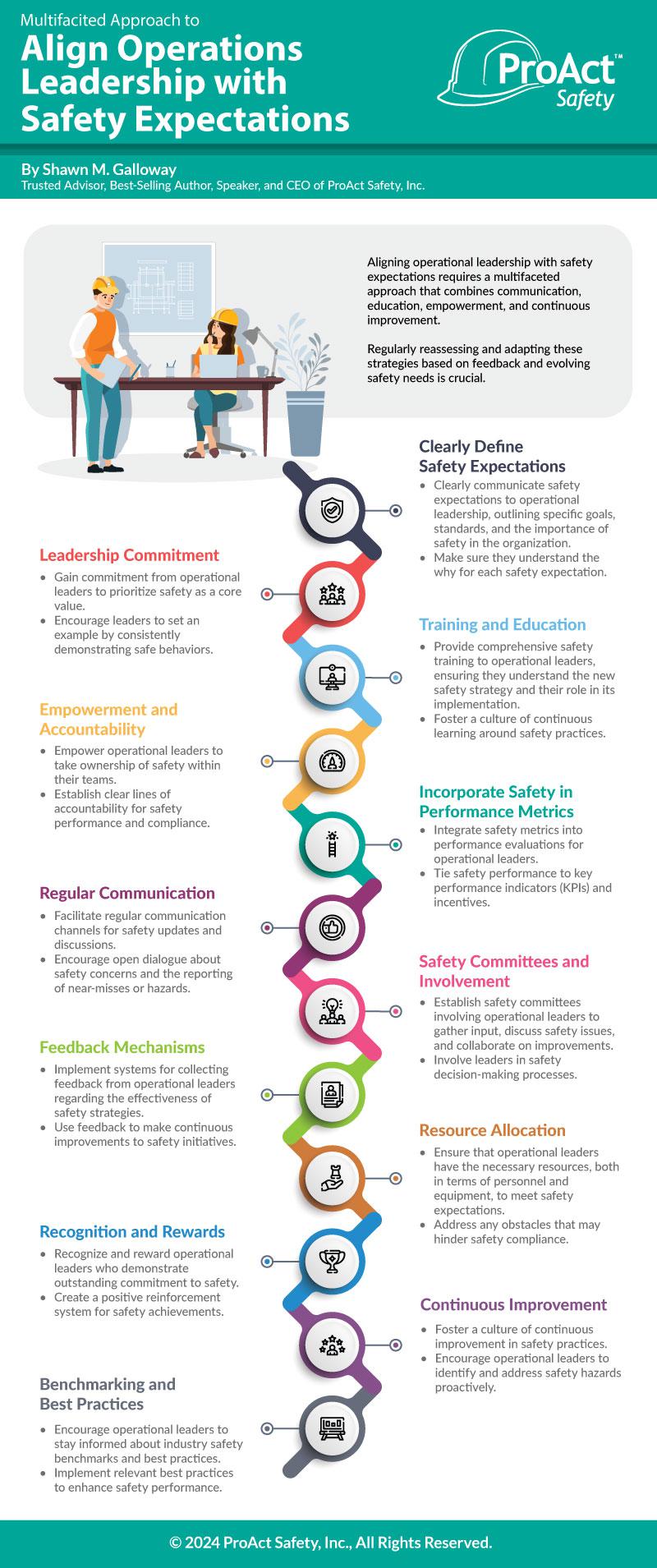May 27 2024
By: Shawn M. Galloway
If safety improvement is your goal, it will never occur sustainably until operational leadership is aligned with clear safety expectations. This article explores the various components necessary to focus, and the steps that can be taken to ensure its success.
Clearly Define Safety Expectations: The first crucial step in aligning operational leadership with safety expectations is clearly defining these expectations. It is vital to communicate safety goals and standards, emphasizing the integral role of safety in the organization. Operational leaders need to understand the rationale behind each safety expectation, as this will help them internalize and prioritize safety within their teams.
Leadership Commitment: Operational leaders are pivotal in prioritizing safety as a core value. Their behavior should consistently reflect this commitment, addressing positive or concerning observations immediately every time. When leaders prioritize safety, it sends a clear message to their teams that safety is a top priority. This commitment should be visible in their actions, decisions, and daily operations.
Training and Education: Comprehensive safety training for operational leaders is vital. This training should ensure that operational leaders understand the new safety strategy and their role in its implementation. By fostering a culture of continuous learning around safety practices, operational leaders can stay updated with the latest safety protocols and effectively implement them within their teams.
Empowerment and Accountability: Leaders must feel empowered to take ownership of safety within their teams. This can be achieved by establishing clear lines of accountability for safety performance and compliance. When leaders are empowered and held accountable for safety performance and outcomes, they are more likely to take proactive measures to ensure a safe working environment.
Incorporate Safety in Performance Metrics: To ensure that safety is given due importance, it is essential to integrate safety metrics into performance evaluations for operational leaders. By tying safety performance to key performance indicators (KPIs) and incentives, leaders will be motivated to prioritize safety and work towards achieving safety improvement goals.
Regular Communication: Facilitating regular communication channels for safety updates and discussions is crucial to ensure leaders stay informed about any safety concerns, updates, or changes. Open dialogue about safety concerns and reporting near-misses or hazards should be encouraged to ensure that safety is always a topic of discussion.
Safety Committees and Involvement: Establishing safety committees involving operational leaders can provide a platform for gathering input, discussing safety issues, and collaborating on improvements. This involvement of leaders in safety decision-making processes ensures that their perspectives and expertise are considered when implementing safety initiatives.
Feedback Mechanisms: Implementing systems for collecting feedback from operational leaders regarding the effectiveness of safety strategies is fundamental to the ability to improve continuously. This feedback can help identify gaps or shortcomings in the safety initiatives and allow for continuous improvements. By actively seeking feedback from leaders, organizations can ensure that safety strategies are aligned with the evolving needs of the workforce.

Resource Allocation: Senior leaders must ensure that leaders close to the work have the necessary personnel and equipment resources to meet safety expectations. Any obstacles hindering safety compliance should be addressed promptly to ensure a safe working environment.
Recognition and Rewards: Recognizing and rewarding operational leaders who demonstrate outstanding commitment to safety is an effective way to align leadership. By creating a positive reinforcement system for safety achievements, leaders will be motivated to prioritize safety and go above and beyond to ensure a safe working environment and a culture of safety excellence.
Continuous Improvement: Fostering a culture of constant improvement in safety practices is essential in aligning operational leadership with safety expectations. Operational leaders should be encouraged to proactively identify and address safety hazards, ensuring safety remains a top priority.
Benchmarking and Best Practices: It is crucial to encourage operational leaders to stay informed about industry safety benchmarks and best practices. By implementing relevant best practices, leaders can enhance safety performance and ensure that their teams utilize the most effective safety protocols.
Aligning operational leadership with safety expectations requires a multifaceted approach that combines communication, education, empowerment, and continuous improvement. By clearly defining safety expectations, gaining leadership commitment, providing comprehensive training, empowering leaders, incorporating safety in performance metrics, facilitating regular communication, involving leaders in safety committees, implementing feedback mechanisms, ensuring resource allocation, recognizing and rewarding safety achievements, fostering continuous improvement, and benchmarking best practices, organizations can create a work environment and culture conducive to the pursuit of safety excellence. Regularly reassessing and adapting these strategies based on feedback and evolving safety needs is a necessary final step to ensure the sustainable performance improvement one should experience, with the dedication to providing this alignment yields the new way leaders lead throughout the company.
"Treat a man as he is and he will remain as he is. Treat a man as he can and should be and he will become as he can and should be." — Stephen R. Covey
"Blessed is he who expects nothing, for he shall never be disappointed." — Alexander Pope
"A major reason capable people fail to advance is that they don’t work well with their colleagues." — Lee Iacocca

Shawn M. Galloway is the CEO of ProAct Safety and an advisor to leading organizations across all major industries. With over twenty years of experience in safety systems, strategy, culture, leadership, and employee engagement, he is a trusted advisor, keynote speaker, and expert witness.
He is the author of several bestselling books and has multiple regular columns in leading magazines, with over 400 articles and 100 videos to his credit. He also created the first safety podcast, Safety Culture Excellence, with over 800 episodes. Shawn has received numerous prestigious accolades and has been featured in Power 101 Leaders of the EHS World, Top 50 People Who Most Influenced EHS, Top 40 Rising Stars, Top 11 Health and Safety Influencers, and Top 10 Speakers.
He serves on the Harvard Business Review Advisory Council and the Fast Company Executive Board. He has appeared as a guest on Bloomberg, Fox News, The Daily Mail, Dubai One, U.S. News & World Report, Sirius Business Radio, Wharton Business Daily, and leading safety magazines and podcasts, reinforcing his status as an authority in the field of safety excellence.
For more information, call +1.936.273.8700 or email info@ProActSafety.com.
